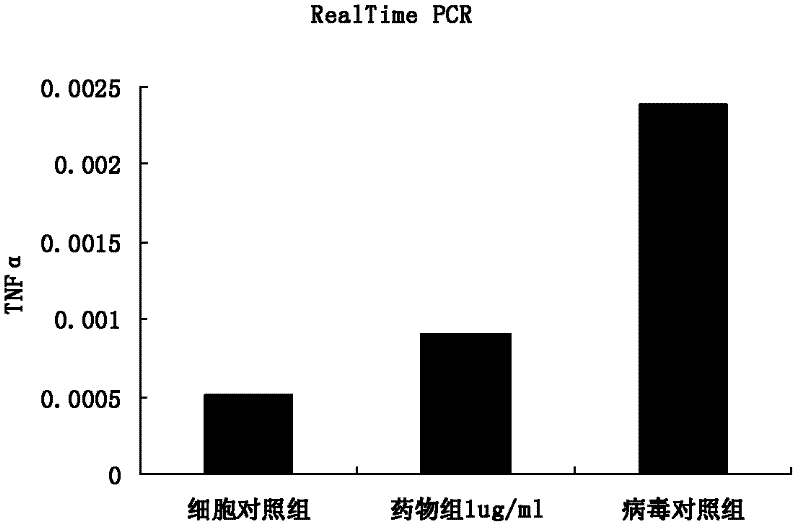Application of matrine to medicament for treating or preventing enterovirus 71 type infection
A technology of enterovirus and matrine, which is applied in the field of medicine, can solve the problems that the mechanism has not been detailed, and the prevention and treatment effects have not been mentioned and applied, so as to improve the quality of treatment and drug compliance, reduce the pain of treatment, Tolerance-enhancing effects
- Summary
- Abstract
- Description
- Claims
- Application Information
AI Technical Summary
Problems solved by technology
Method used
Image
Examples
Embodiment 1
[0052] Drug toxicity test (MTT method)
[0053] After 24-48 hours of culture, when the RD cells are almost covered with a single layer, the culture medium is discarded, digested with trypsin, and transferred to a 96-well sterile cell culture plate, 100 μl per well. Place it in a cell culture incubator for 18-24 hours to make the cells grow into a single layer for later use. The drug was diluted step by step with cell culture medium. After dilution, add different concentrations of drugs into the cell culture wells where the supernatant was discarded, 100 μl per well, repeat 3 wells for each concentration, and set up cell control wells (no drugs, only culture medium), and then Add 100 μl of cell culture medium, place in a 37°C, 5% CO2 incubator, and cultivate for 48 hours, then add 20ul of MTT solution (5mg / ml prepared in PBS, pH=7.4) to each well. Continue to incubate for 4h, terminate the culture, be careful Aspirate and discard the culture supernatant in the well. For suspe...
Embodiment 2
[0057] Determination of half infectious dose (TCID50) of EV71 on cells
[0058] Transfer the RD cells cultured into a single layer to a 96-well cell culture plate, and place them in a cell culture incubator for 18-24 hours. The virus liquid was serially diluted 10 times (10-1...10-8) with the maintenance solution. Discard the culture medium in each well of the RD cultured into a single layer, wash each well with PBS 3 times, add 100 μl of virus solution of different concentrations to each well, absorb at 37°C for 1.5 h, discard the virus dilution solution, and add 100 μl to each well Maintenance solution, 10 repetitions for each concentration, set normal cell control wells. The cytopathic changes (CPE) in each well were observed daily for 3 consecutive days, and the CPE conditions were recorded. The titer of the virus was then calculated by the following formula.
[0059] PD / [log(dilution above 50%)-log(dilution below 50%)]=[(%next above 50%)-50%] / [(%next above 50%)-(%next ...
Embodiment 3
[0062] Antiviral Effect of Matrine on EV71
[0063] 1) Preventive effect of matrine on EV71 virus infection
[0064] After 24-48 hours of culture, when the RD cells are almost covered with a single layer, the culture medium is discarded, digested with trypsin, and transferred to a 96-well sterile cell culture plate, 100 μl per well. Place it in a cell culture incubator for 18-24 hours to make the cells grow into a single layer for later use. The drug was diluted step by step with cell culture medium. After dilution, add different concentrations of drugs into the cell culture wells where the supernatant was discarded, 100 μl per well, repeat 3 wells for each concentration, and set up cell control wells (no virus, no drug, only culture solution) and Virus control wells (without adding drugs, adding virus, and adding culture medium). After drug incubation for 1 hour, discard the supernatant, wash three times with PBS, add virus diluted with culture medium, 100 μl per well, inc...
PUM
 Login to View More
Login to View More Abstract
Description
Claims
Application Information
 Login to View More
Login to View More - R&D
- Intellectual Property
- Life Sciences
- Materials
- Tech Scout
- Unparalleled Data Quality
- Higher Quality Content
- 60% Fewer Hallucinations
Browse by: Latest US Patents, China's latest patents, Technical Efficacy Thesaurus, Application Domain, Technology Topic, Popular Technical Reports.
© 2025 PatSnap. All rights reserved.Legal|Privacy policy|Modern Slavery Act Transparency Statement|Sitemap|About US| Contact US: help@patsnap.com



